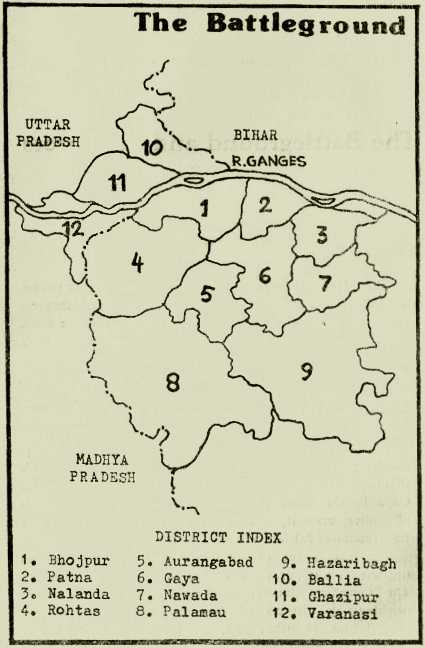The Battleground and the Forces
THE plains and forests of Bihar are ablaze. From Purnea to Palamau and Bhojpur to Bhagalpur, agricultural labourers and poor peasants are up in arms throughout the State. Armed clashes between the private armies of landlords and the peasants often running for hours together, killings of notorious landlords and murders of peasant leaders, police firings on processions and mass meetings, cold-blooded murders of revolutionaries in police encounters, peasant guerilla squads overrunning police camps to seize rifles, strikes of agrarian labourers, and landlord gangs indulging in pogroms are all regular features in today’s Bihar. The latest massacre of over 60 people at Arwal in Gaya by the Bihar Police has surpassed all previous records of police brutality and has been rightly termed as the resurrection of Jallianwallabagh on the soil of Bihar.
 The main arena of the battle is confined to the central districts of Bhojpur, Gaya, Patna, Nalanda and Aurangabad. The immediate impact of the struggle stretches to the neighbouring districts of Nawada, Hazaribagh, Palamau and Rohtas in Bihar and, to a certain extent, also to Varanasi, Ghazipur and Ballia, the bordering districts of Eastern Uttar Pradesh.
The main arena of the battle is confined to the central districts of Bhojpur, Gaya, Patna, Nalanda and Aurangabad. The immediate impact of the struggle stretches to the neighbouring districts of Nawada, Hazaribagh, Palamau and Rohtas in Bihar and, to a certain extent, also to Varanasi, Ghazipur and Ballia, the bordering districts of Eastern Uttar Pradesh.
The principal organisations siding with the peasants are the CPI(ML) (Liberation), the CPI(ML) (Party Unity) and the Maoist Communist Centre (MCC). In some pockets, actions of the PCC, CPI(ML) and certain pro-Lin Piao groups are also active. The Chhatra-Yuva Sangharsh Vahini, an organisation basing on JP’s ideas, has also developed struggles in a few pockets. While various peasant mass organisations—open, semi-open and secret—built up by different M-L groups stand in the forefront of the struggle; peasant guerilla squads, armed with the guns and rifles seized from the landlords and the police and popularly known as the Red Army or Red Guard, provide the backbone.
On the side of the landlords are ranged almost all the major political parties, the Congress(I) assuming the principal role. The CPI is most vociferous in opposing the revolutionary camp and openly colludes with the Congress(I), the landlords and the state in splitting and suppressing the movement. For the CPI as well as the CPI(M), the latter however is the weaker partner in Bihar, the Naxalites are pitting agrarian labourers against the peasants, providing, in the process, excuses to the state for unleashing severe repression on the masses—and all this at the behest of the CIA.
However, since different opposition parties and dissident Congress factions have contradictions with the ruling Congress as well as among themselves, they try to utilise the peasant struggle and particularly the instances of repression for their narrow political ends. The Lok Dal, the main opposition party in Bihar, alarmed as it is at its slipping hold over the harijans and backward castes, frantically opposes all class-based mobilisations of the peasantry, always striving to isolate and split the forces of revolutionary democracy. However, the same motive of protecting its own social base also makes it show concern over the repression let loose by the upper-caste landlords and the police on the agrarian labourers and poor peasants from among the harijans and backward castes.
These political parties apart, there are the caste-based private armies of the landlords, propped up in collaboration with the state.
Apart from the regular opposition parties there are also many splinter organisations and groups subscribing to the philosophies of Gandhi, Vinoba Bhave and JP as well as various voluntary agencies undertaking so-called developmental activities. Majority of them rely on foreign funding and work with the avowed aim of disrupting the peasant movement. However, some sections among them comprising idealist students and youths do cooperate with the forces of revolutionary democracy.
Various streams of Jharkhand movement do not have any well-defined programme for the adivasi peasants. However, in some cases they do undertake struggles against eviction and exploitation by the merchants and moneylenders and for the right on forest land and forest produce and also for social progress. And at times they, too, cooperate with the forces of revolutionary democracy.
